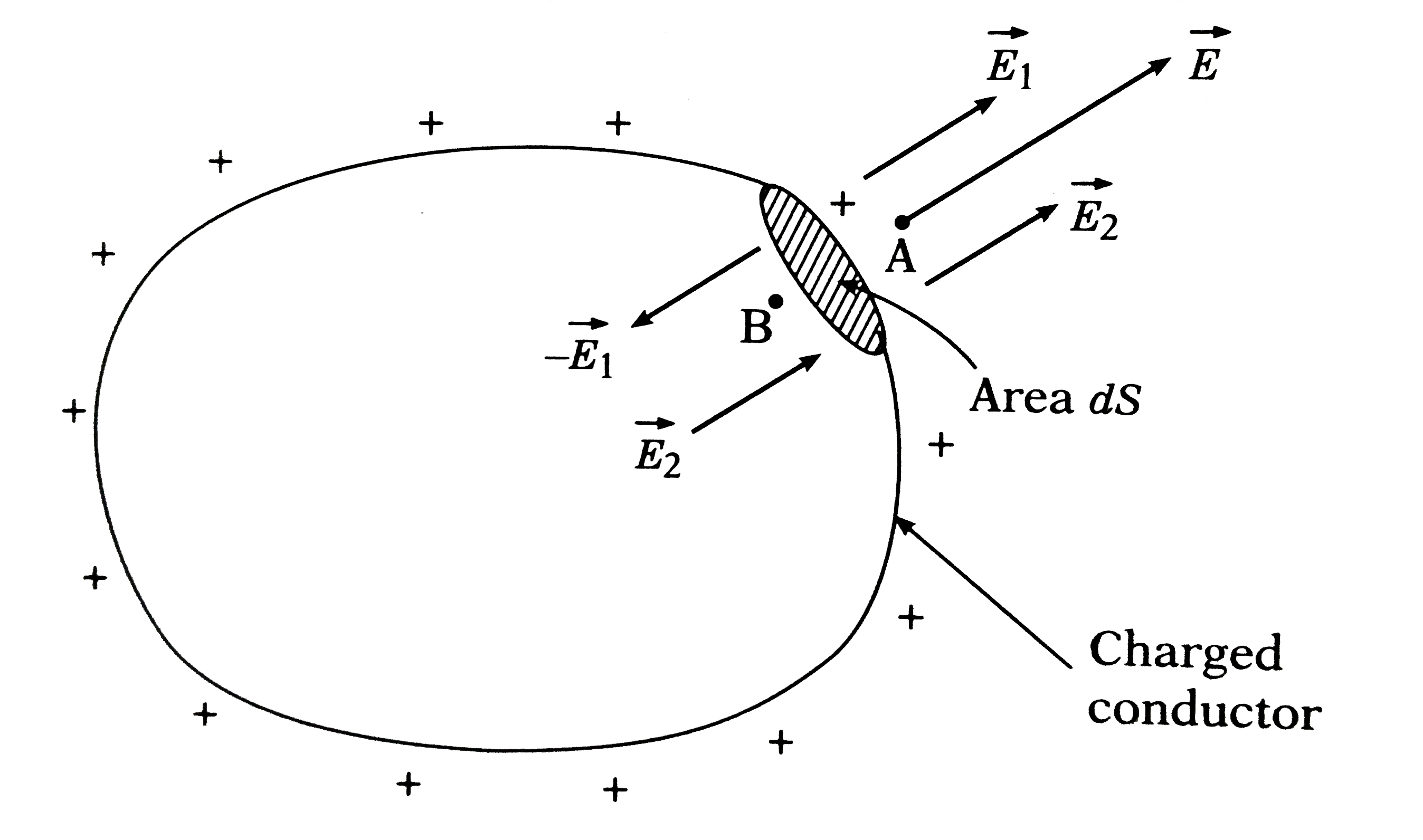The mechanical force acting on a unit area of a charged conductor is
Consider a positively charged conductor of any shape placed in a dielectric medium of permittivity ε. Let dS be a very small area of the surface of the conductor drawn around point A as shown in the figure. If σ is the surface charge density on dS, the charge on the area element =σdS and the electric field intensity at a point just outside the area element has a magnitude E=σε.
→E can be considered as a resultant of: (i) →E1 due to the charge on area dS and (ii) →E2 due to the charge on the remaining part of the conductor. Since →E1and→E2 have the same direction,
E=E1+E2 ...(1)

→E1 has opposite directions on the two sides of dS, but on both sides, →E2 is directed along the outward normal to the element.
At point B inside the conductor, the electirc field is zero.
∴E2−E1=0
∴E2=E1
At A, just outside the conductor, E1+E2=E
∴E1=E2=12E
But , E=σε ...(2)
∴E1=E2=σ2ε ...(3)
Thus, the charged area element σdS is situated in an electric field of magnitude E2=σ2ε, produced by the charge on the rest of the conductor and this field is outward. The force acting on dS due to the action of this field
= ( charge on area dS) × ( electric field due to the remaining charge)
∴F=σdS×σ2ε=σ22εdS ...(4)
This force acts outward, normal to the surface. The magnitude of the mechanichal force per unit area of the surface is
f=FdS=σ22ε=σ22ε0k ...(5)
where ε0 is the permittivity (dielectric constant) of the medium.
From Eq. (2),
σ=εE=ε0kE
Substituting this value of σ in Eq. (5),
f=(ε0kE)22εk=12ε0kE2 ...(6)
Thus, the mechanical force per unit area of a charged conductor,
f=σ22ε0korf=22kE2
Topper's Solved these Questions
- DERIVATIONS-IIBook:NAVNEET PUBLICATION - MAHARASHTRA BOARDChapter:DERIVATIONS-IIExercise:Current Electricity
Explore 6 Videos
- DERIVATIONS-IIBook:NAVNEET PUBLICATION - MAHARASHTRA BOARDChapter:DERIVATIONS-IIExercise:Magnetism
Explore 1 Video
- DERIVATIONS-IIBook:NAVNEET PUBLICATION - MAHARASHTRA BOARDChapter:DERIVATIONS-IIExercise:Interference and Diffraction
Explore 4 Videos
- DERIVATIONS-IBook:NAVNEET PUBLICATION - MAHARASHTRA BOARDChapter:DERIVATIONS-IExercise:Assignments
Explore 9 Videos
- DISTINGUISH BETWEENBook:NAVNEET PUBLICATION - MAHARASHTRA BOARDChapter:DISTINGUISH BETWEENExercise:Assingment
Explore 3 Videos
Similar Questions
Knowledge Check
Which of the following factors does not affect the mechanical force per unit area of charged conductor ?
ASurface charge densityBElectric field intensityCPermittivity of mediumDDistance of point
Force acting per unit area of each plateA12μ0j2BzeroCm0jD2m0A charged conductor of area ds is placed in electric field of strength E. The force acting on unit area of the conductor is
A∈0kE22B∈0k2ECE22∈0kD∈0kE2
Force acting on a unit area is called _____
View SolutionState the principle on which transformer works. Explain its working with construction. Derive an expression for ratio of e.m.f.s and currents in terms of number of turns in primary and secondary coil.
A conductor of any shape, having area 40cm2 placed in air is uniformaly charged with a charge 0.2μC. Determine the electric intensity at a point just outside its surface. Also, find mechanical force per unit area of the charged conductor.
[ε0=8.85×10−12 S.I. units]
View SolutionThe surface density of charge on the surface of a charged conductor in the air is 26.5μCm−2 . The the outward force per unit area of the charged conductor is (ε0=8.85×10−12C2N−1m−2)
View SolutionTwo long, thin parallel conductors, separated by a distance d, carrying currents i1 and i2. The force acting on unit length of any one conductor is F
View SolutionThe surface density of charge on the surface of a charged conductor in air is 0.885μC/m2. If ε0=8.85×10−12C2/N−m2, then the outward force per unit area of the charged conductor is
View Solution

